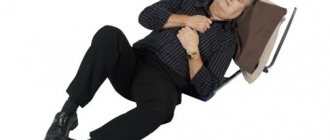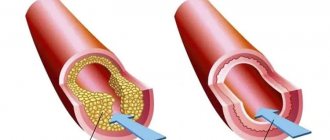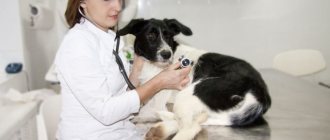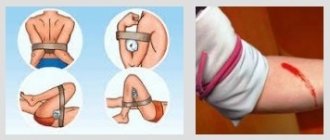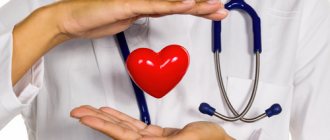Heart attack symptoms are characteristic signs that indicate the development of myocardial infarction. Every year, tens of thousands of people die as a result of a heart attack, and this condition also leads to disability. You can prevent dangerous consequences if you seek medical help in the early stages of a heart attack—immediately after the symptoms of a heart attack appear. In this case, the patient will be helped by emergency cardiology, which specializes in treating patients with suspected heart attacks.
Why is it useful to know about the symptoms of a heart attack?
It is important for patients suffering from diseases of the cardiovascular system and their loved ones to know about the symptoms of heart attacks, because heart attacks occur in people who felt absolutely healthy just yesterday. The risk group includes older and elderly people, patients with coronary heart disease. Risk factors include smoking and lack of physical activity, and a genetic predisposition to heart and vascular diseases. Atherosclerosis of the heart vessels often leads to heart attacks. This is a disease in which cholesterol plaques form in the coronary arteries. Arterial blood does not fully flow to the heart when the vessels are narrowed and the vascular lumen is blocked. Read more about the main causes of heart attacks here.
Even with a favorable outcome, when the patient’s life was saved, there is a risk that he will have to face various complications. For example, after a heart attack, arrhythmia occurs and a pacemaker is required. It is important to know what signs indicate a heart attack, because timely assistance helps prevent irreparable consequences.
Surgical methods
In addition to drug therapy, the following procedures are offered for effective treatment of myocardial infarction:
- Coronary angioplasty and stenting;
An emergency angioplasty procedure aims to open a blocked artery, allowing blood to flow freely to the myocardium. The doctor will insert a special long, thin tube (catheter) into the blocked coronary artery through an artery in the leg in the groin area or in the arm in the wrist area. Through this catheter, a special guide and balloon are brought to the affected area of the artery.
The balloon is guided through a guidewire to the affected area of the artery and inflated, facilitating the opening of the vessel. After this, a metal stent is implanted into this section of the artery - it will maintain the artery in a straightened state for a long time. It is better to implant a stent with a drug coating, which prevents restenosis - repeated narrowing of the vessel in this area. Read more about the benefits of balloon angioplasty here.
- Coronary bypass surgery;
In difficult cases, cardiac surgeons perform emergency coronary bypass surgery during a myocardial infarction. Coronary bypass surgery involves suturing a vein or artery to a coronary artery in a place after blockage or narrowing of the latter, thus restoring blood flow through the vessel.
Warning signs of a heart attack
An early warning of myocardial infarction is repeated chest pain that occurs during exercise and goes away with rest (angina pectoris). Angina occurs as a result of a temporary decrease in blood supply to the heart in conditions of increased oxygen demand. We talked in detail about the characteristic symptoms of angina here.
People confuse the concept of a heart attack with a condition in which the heart suddenly stops (sudden cardiac arrest). Sudden cardiac death occurs as a result of electrical dysfunction in the heart, impairing pumping function and leading to cessation of circulation throughout the body. Myocardial infarction is a common, but not the only, cause of cardiac arrest.
What to do if you see a person with a developing myocardial infarction?
If you encounter an unconscious person due to a suspected myocardial infarction, call an ambulance. If you are trained in first aid, begin cardiopulmonary resuscitation (CPR). This will help deliver oxygen to the body and brain.
Begin CPR with chest compressions. Press down on the chest about 5 cm with each compression at a rate of about 100 compressions per minute. If you are trained in CPR, check the person's airway and give breaths every 30 compressions. If you are not trained in CPR, continue to perform chest compressions only.
First aid
If you have a heart attack, act immediately. Many people wait too long because they do not recognize warning signs. Take the following steps:
- Call an ambulance. If you suspect a myocardial infarction, do not hesitate to call. Immediately dial 03, 911 or 112. If you do not have access to a telephone, find someone who can take you to the nearest medical facility or heart center. If you drive in this condition, you are putting yourself and others at serious risk.
- Take nitroglycerin if you have been prescribed it. If your doctor prescribed nitroglycerin, take it as directed while you wait for emergency personnel to arrive.
- Take aspirin if it is recommended for you. If you are concerned about your risk of heart attack, ask your cardiologist if you can chew an aspirin tablet. Taking aspirin during a developing heart attack will help reduce damage to the heart by reducing blood clots.
Additional Research
If you have a heart attack, your cardiologist will begin immediate treatment efforts. Additional research:
- X-ray examination of the chest organs. A chest x-ray will help the doctor evaluate the size of your heart and the vascular pattern of your lungs and the presence of fluid in the pleural cavity.
- Echocardiography. This test is based on the emission and recording of reflected sound waves that create an image of the heart on a monitor. Echocardiography helps visualize the part of the myocardium that is damaged as a result of a heart attack and is not able to normally push blood through the vessels.
- Coronary angiography (catheterization of the coronary arteries). This type of coronary exam will show narrowing or blockage in the arteries that supply blood to the heart (coronary arteries). A liquid X-ray contrast agent fills the arteries supplying blood to the heart through a long, thin catheter. It is at the mouth of the coronary arteries through the femoral artery (in the groin area) or the radial artery (in the wrist area). When the arteries are filled with contrast, they become visible under X-ray guidance, revealing narrowing of the lumen and its complete blockage. In addition, since the artery is accessible, the doctor can treat coronary artery disease by performing coronary angioplasty and coronary artery stenting. During angioplasty, thin balloons are used that are delivered to the site of narrowing of the artery and inflated, expanding the lumen. In most cases, a mesh tube called a stent is then placed in this area of the artery. It keeps the artery open and prevents re-stenosis of the vessel lumen in the future.
- Stress test with load. Several days or weeks after your heart attack, you may be given a stress test. A stress test diagnoses how your heart and blood vessels respond to stress. You will walk on a treadmill or pedal a bicycle ergometer while an ECG or ECHO is recorded. If the patient is not ready for exercise, he is prescribed medications that stimulate the heart. A stress test will help your doctor determine the best treatment option. If your doctor wants to see an image of your heart during exercise, he will order a myocardial scintigraphy, a test similar to an exercise stress test that uses a special radiopharmaceutical and special imaging techniques.
- Coronary computed tomography (CT) or magnetic resonance imaging (MRI). This test is used to diagnose heart disease, including damage due to myocardial infarction. During a CT scan, you will lie on a table inside a tunnel-like machine. An X-ray machine rotates in this tunnel, recording and creating a series of images of your heart and chest organs. During this test, a radiopaque contrast agent is sometimes injected to visualize the coronary arteries. During an MRI, the patient lies on a table inside a similar tube-like machine that creates a magnetic field. The magnetic field arranges the atoms of cells in a certain way, and the device registers radio waves as a result of this rearrangement, depending on the type of tissue. These signals are processed and create an image of the heart.
Receiving Prescriptions
If you have a myocardial infarction, it is usually diagnosed by emergency physicians, or less often when visiting a doctor. After a heart attack, it is recommended to take care of yourself and be attentive to your health: early post-infarction angina leads to repeated heart attacks.
If you are interested in reducing your risk of heart attack, talk to your cardiologist about risk factors and ways to prevent heart attacks.
Since doctor's orders can be laconic and not always clear, it is a good idea to prepare for a consultation with a cardiologist. Below is information to help you prepare for your doctor's orders.
Complications
Complications of myocardial infarction are associated with myocardial damage. This damage leads to the following conditions:
- Heart rhythm disturbances (arrhythmias). Types of arrhythmia are bradycardia and tachycardia. As a result of damage to the heart muscle due to a heart attack, electrical instability of the myocardium develops. It manifests itself as an abnormal heart rhythm and can be serious, even fatal. In this case, the patient is advised to install a pacemaker.
- Cardiogenic shock. Another deadly condition that accompanies myocardial infarction. In severe heart attacks, the heart loses its ability to pump blood—cardiogenic shock occurs.
- Myocardial rupture. An area of the myocardium weakened by the infarction may rupture, creating a hole in part of the heart. This complication is fatal.
- Heart failure. The amount of damaged heart muscle as a result of a heart attack can be so great that the remaining part of the myocardium is not able to adequately perform its job of delivering blood to the organs and tissues of the body. Reduced blood flow to organs and tissues leads to shortness of breath, increased fatigue and swelling of the legs. Heart failure is temporary and resolves after some of the damaged myocardium (stunned myocardium) has recovered, usually within a few days or weeks. There is also a chronic condition if a large area of the myocardium is irreversibly damaged.
- Heart aneurysms. Necrotic areas of the heart muscle are replaced by connective tissue. As a result, post-infarction cardiosclerosis develops, which leads to protrusion of the heart wall - an aneurysm.
- Problems with the heart valves. If parts of the heart valve apparatus are damaged as a result of a myocardial infarction, this leads to serious or even life-threatening valvular insufficiency.
How to prepare for a doctor's appointment?
- Write down any symptoms you experience, including those that do not seem like symptoms associated with heart disease.
- Write down personal information that includes a family history of vascular or heart disease, stroke, high blood pressure, or diabetes; stressful situations or changes in lifestyle.
- Make a list of all medications, including vitamins and supplements, that you take.
- Ask your family or friends if they remember any information that would indicate heart disease.
- Be prepared to discuss your diet and lifestyle. If you are not following a diet or exercising regularly, be prepared to receive instructions from your doctor about lifestyle changes you should make during treatment.
- Write down questions you want to ask the doctor.
Your appointment time with your doctor is limited, so try to come up with a list of questions that can help you have an effective consultation. Here is a sample list of questions:
- What causes these symptoms and condition?
- What treatment is indicated for me?
- What foods should I eat and what should I avoid?
- What is the acceptable level of physical activity for me?
- How often should I check my cholesterol and have a cardiac screening?
- If I have other health problems, how can I treat them together?
- Are there any restrictions?
- Should I consult other specialists?
- Are there alternative drugs to the drugs that were prescribed to me?
- Are there any brochures or other self-study materials available? What websites do you recommend?
What to expect from the doctor?
The doctor will ask questions - be prepared to answer them. When you see a cardiologist, you will be asked:
- When did you first experience symptoms that seemed suspicious for heart disease, such as chest pain (angina) or shortness of breath?
- Are the symptoms continuous or sudden?
- How severe are your symptoms?
- What helps resolve these symptoms? If you experience chest pain, does it go away with rest?
- What worsens or triggers symptoms? If chest pain occurs, does physical activity make it stronger and help it continue?
- Has there been a history of heart disease in your family?
- Have you been diagnosed with high blood pressure, high cholesterol or diabetes?
Panic attack
Here the nature of the pain is completely different. It feels sharp and stabbing. Localized in one place, usually in the middle of the chest. No squeezing sensations are observed. Also characteristic signs of a panic attack will be:
- increased heart rate,
- lack of air, severe shortness of breath,
- sensations of numbness in the limbs or face,
- dizziness,
- dilated pupils.
In addition, the stomach may stop working. But the main symptom is a strong, all-encompassing feeling of fear. A person is afraid of losing control over himself, of doing something irreparable, and is also afraid of dying, since it seems that his body is already at its limit. This sensation is created by adrenaline, which the body produces in response to fear. Where there is fear, there is danger, which means we must “call everyone up” and fight back.

